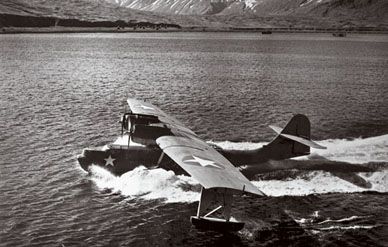Restoration: Going the Distance
The ninth life of a PBY-5A Cat.
FLOYD BENNETT FIELD, A BROOKLYN, NEW YORK AIRPORT THAT SAW ITS GLORY DAYS in the 1930s, is now virtually abandoned save for a buzz of activity in Hangar B, where volunteers for the Historic Aircraft Restoration Project (HARP) are reassembling a handful of vintage aircraft. The most unassembled and the highest priority is a Consolidated PBY-5A Catalina, a large amphibian with a 104-foot wing, out of which protrude a pair of radial engines, giving the airplane a bug-eyed look.
PBY-5As don’t have speed (they lumber along at 117 mph) and they are not exactly nimble (fully fueled they tip the scales at 35,000 pounds), but they do have a range of more than 2,500 miles, and that’s why they were widely used as rescue aircraft and patrol bombers during World War II. Whether hunting down German and Japanese naval vessels or plucking Allied aircrews out of the ocean, Catalinas were a steady presence throughout the war. Twenty-hour missions were not uncommon for the PBYs’ seven- to nineman crews, and their tirelessness paid off: On May 26, 1941, the crew of a British Royal Air Force Catalina spotted the German battleship Bismarck sailing in the north Atlantic and reported its position to the Royal Navy, which sank it the next day.
Catalinas also kept busy in the Pacific as well. There were several U.S. Navy squadrons known as the Black Cats, who flew night missions to disrupt Japanese shipping operations in the Solomon Islands. In PBYs painted black for camouflage, Black Cat crews flew with lights out, unleashing 500-pound bombs on the targets below. To further terrorize Japanese sailors, the Black Cats dropped empty beer bottles, which produced an unsettling whistle as they fell.
Irving Krasner, who is helping to restore the PBY-5A, enlisted in the U.S. Navy in June 1942 and ended up piloting PBYs for Fleet Air Wing 14. Ensign Krasner was assigned to North Island, off San Diego. “Our patrol region encompassed the whole South Pacific,” he recalls, but in 1943 and ’44, he frequently flew on anti-submarine patrols to San Francisco and back at night. As for the airplane, “it was very stable,” says Krasner. “It didn’t have hydraulic controls, so we had to use a lot of muscles to fly it.” And it didn’t have flaps either. With a landing speed of just 60 mph, it didn’t need them.
The restoration crew, led by HARP executive officer Richard Postel, knows little about the PBY’s previous life, except that the craft had been flown in Brazil. Several instruments are in that country’s language, Portuguese, and cartoons of a flying turtle in fading paint on either sides of the vertical stabilizer read “Devagar Mas Ciego Là”—“We’re Slow But We Get There."
Before the PBY became a HARP project, it was overseen by the U.S. Marines based in Cherry Point, North Carolina. It had just barely survived a hurricane. “The Marines loaded the wings with water for ballast but it flipped over anyway,” says Postel. “The wings were sheared off—the whole thing was a wreck.”
A typical PBY carried five machine guns: two .30-calibers in the chin turret, one .30 aft of the step, and two .50s in large side blisters. The HARP Catalina has no such blisters and chin turret; they were probably removed when the airplane was outfitted with bench seats and a toilet for transporting passengers. Postel isn’t yet sure if his team can afford to replace the blisters—they cost $20,000 each—but Krasner may well buy and donate a chin turret.
The volunteers have been working on the PBY for four years, and they expect it will be seven more before it’s ready for static display at Floyd Bennett Field. If you have any information on this aircraft, write to Floyd Bennett Field Hangar B, Brooklyn, New York, 11234-7097, or call (718) 338-5986.
